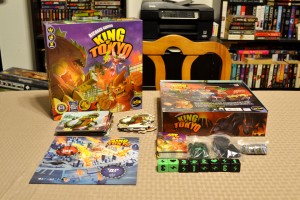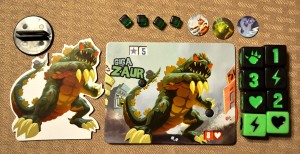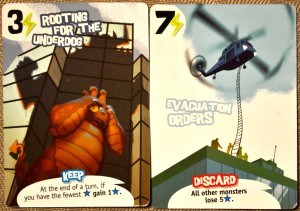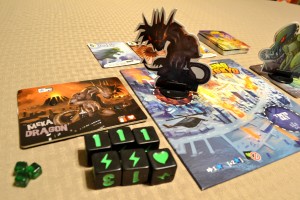I’m not too big on Kaiju movies, but I do enjoy playing Kaiju related games from time to time. “Rampage” for the NES was one of my favorites, even if the monsters’ names were George, Lizzie, and Ralph. “King of Tokyo” puts players in the role of a monster who is wrestling for control of, you guessed it, Tokyo. There’s punching, there’s healing, there’s special abilities…but there can only be one monster left standing at the end of it all. Will it be you?
Components
Monster Figures & Boards – Each of the six cardboard monster figures have an accompanying player board to help the player keep track of their progress throughout the game. The player boards also serve as a “home base” of sorts from which the monsters can attack Tokyo.
Tokyo Board – Players will be battling for control over this board. The monster currently controlling Tokyo typically earns bonus points.
Counters – Various counters are included (smoke, mimic, shrink, poison) to help players keep track of modifiers/debuffs as they are played.
Cards & Energy Cubes – Cards serve as power-ups that the players can purchase (using energy cubes) for their monsters.
Dice – There are a total of eight dice…six black and two green, which are made up of varying symbols. The two green dice are special in that they are only used when a particular card is bought by a player.
Setup & Gameplay
Each player gets a monster and its corresponding board, adjusting the latter so that they start with zero victory points and ten health. The Tokyo board goes in the middle of the table within reach of all players, along with the dice and energy cubes. In a two to four player game, players will only make use of the Tokyo City space. In a five to six player game, players will make use of both the Tokyo City and Tokyo Bay spaces. The deck of cards is shuffled and three are dealt face up. The starting player is determined by rolling the six dice and seeing who has the most “attack” icons showing.
Editor’s Note: For simplicity’s sake, the below omits the advanced rule set (which is used in a five or six player game).
A player’s turn is divided up into four phases:
1. Rolling & Rerolling Dice – The player will roll the six black dice. They can bank what they want to keep and roll again up to two more times. Once a player has rolled three times, they must keep the results.
2. Resolving Dice – Depending on the results, players will take different actions.
A. Victory Points – The dice contain values of 1, 2, or 3. Rolling three of that number wins the player that many victory points. Every subsequent, same number of that set is an extra point (four 2’s equate to three points). Players can also earn victory points by taking control of Tokyo, as well as remaining there for a full round.
B. Attack – Each attack does one point of damage by default. If you’re in Tokyo, you’ll do damage to all other players. If you’re on your player board, you’ll do damage to the monster currently occupying Tokyo. When Tokyo is empty, no damage is done but the player has the option to move their monster there. When a player takes damage in Tokyo, they can retreat back to their player board (though they’ll still take damage). The attacker will take the retreating player’s place.
C. Energy – Each energy symbol provides the player with one energy cube.
D. Heal – Each heal symbol provides the player with one life. Monsters do not heal while occupying Tokyo.
3. Buying Cards – The player may spend energy cubes to buy any of the three face-up cards. In addition, a player can spend two energy to refresh those three face-up cards with new ones.
4. End Turn.
Players will continue taking turns until someone reaches twenty points or is the last monster standing. Whoever fulfills these game ending conditions first will win the game!
The above doesn’t cover all of the rules found in the manual, but should give you an idea as to how the game is played.
The Review
The components were of decent quality. While most of it was either plastic or cardboard, I didn’t feel I’d accidentally break the pieces just by holding them. The learning curve is either light or moderate, depending on whether or not you’re playing a two to four player game or five to six player game. The advanced rule set includes the use of Tokyo Bay, a second space on the Tokyo board. There’s a lot more “if-thens” to consider when using the advanced rule set and the rules, I feel, could have done a better job in outlining them. Simple bullet points or a chart would have been helpful. Some of the mechanics (like whether or not monster damage each other in Tokyo) weren’t even brought up except for in the example.
While the game isn’t overly complicated, there are some choices the player will need to make over the course of the game. The majority of these choices lie with the risk-taking aspect of the game in regards to whether or not players decide to actively occupy Tokyo. While occupying Tokyo grants the invader an immediate bonus and rewards points over time, the player cannot heal and will be at risk from attacks by every other player in the game. In theory, players could play it safe and stay on their home board and rely on rolling victory points (three of a kind or more)…though taking the risk of occupying Tokyo might give the push a player needs to win the game.
The cards also add a bit of variety to play. There’s also a bit of strategy here, as players will need to decide whether or not they want to focus on these cards at all. Spending time accumulating energy cubes (by rolling energy symbols) is a risk in itself, as that is potentially fewer points that you’re earning while you do so. Most of the cards do provide a fairly significant benefit however, both offensively and defensively. There’s also some that grant victory points, so giving up those victory point rolls may pay off in the end. Again, there’s a risk/reward system at work that players will need to constantly take into consideration.
All in all, “King of Tokyo” turned out to be a fun, light dice rolling game. It can be a little luck based in that what you roll is what you get, but the game makes up for it by allowing you to bank dice a few times before you have to settle with the end result. The cards and the constant positional play between the player boards and Tokyo keep things interesting and make you forget about any bad rolls that you happen to get. I feel that there’s a good mix of chance and choice, to the point where one doesn’t seem to be overshadowing the other. At the very least, it’s a great game to play with kids…though playing with a group of adults is certainly viable.
Final Verdict: 8/10
—
You can read my review of the “Power Up!” expansion here:
http://www.dadsgamingaddiction.com/king-of-tokyo-power-up/
—




